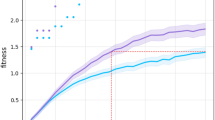Abstract
This paper describes a study in evolutionary robotics conducted completely in hardware without using simulations. The experiments employ on-line evolution, where robot controllers evolve on-the-fly in the robots’ environment as the robots perform their tasks. The main issue we consider is the feasibility of tackling a non-trivial task in a realistic timeframe. In particular, we investigate whether a population of six robots can evolve foraging behaviour in one hour. The experiments demonstrate that this is possible and they also shed light on some of the important features of our evolutionary system. Further to the specific results we also advocate the system itself. It provides an example of a replicable and affordable experimental set-up for other researches to engage in research into on-line evolution in a population of real robots.
Access this chapter
Tax calculation will be finalised at checkout
Purchases are for personal use only
Similar content being viewed by others
Notes
- 1.
- 2.
The code for implementation is available on https://github.com/ci-group/Thymio_swarm.
References
Bongard, J.: Evolutionary robotics. Comm. ACM 56(8), 74–85 (2013)
Bredeche, N., Haasdijk, E., Eiben, A.E.: On-line, on-board evolution of robot controllers. In: Collet, P., Monmarché, N., Legrand, P., Schoenauer, M., Lutton, E. (eds.) Proceedings of the 9th International Conference on Artificial Evolution, pp. 110–121. Springer, Berlin (2009)
Bredeche, N., Montanier, J.M., Liu, W., Winfield, A.F.: Environment-driven distributed evolutionary adaptation in a population of autonomous robotic agents. Math. Comput. Model. Dyn. Syst. 18(1), 101–129 (2012)
Capi, G.: Multiobjective evolution of neural controllers and task complexity. IEEE Trans. Robot. 23(6), 1225–1234 (2007)
Doncieux, S., Bredeche, N., Mouret, J.B., Eiben, A.: Evolutionary robotics: what, why, and where to. Front. Robot. AI 2(4) (2015)
Eiben, A.E., Haasdijk, E., Bredeche, N.: Embodied, on-line, on-board evolution for autonomous robotics. In: Levi, P., Kernbach, S. (eds.) Symbiotic Multi-Robot Organisms: Reliability, Adaptability, Evolution, pp. 361–382. Springer, Heidelberg (2010). http://www.springer.com/engineering/mathematical/book/978-3-642-11691-9
Heinerman, J., Rango, M., Eiben, A.: Evolution, individual learning, and social learning in a swarm of real robots. In: Proceedings of the 2015 IEEE International Conference on Evolvable Systems (ICES). IEEE (2015, to appear)
Ishiguro, A., Tokura, S., Kondo, T., Uchikawa, Y., Eggenberger, P.: Reduction of the gap between simulated and real environments in evolutionary robotics: a dynamically-rearranging neural network approach. In: IEEE SMC 1999 Conference Proceedings, IEEE International Conference on Systems, Man, and Cybernetics, vol. 3, pp. 239–244. IEEE (1999)
Morán, F., Merelo, J.J., Moreno, A., Chacon, P. (eds.): ECAL 1995. LNCS, vol. 929. Springer, Heidelberg (1995)
Nehmzow, U.: Physically embedded genetic algorithm learning in multi-robot scenarios: the pega algorithm. In: Prince, C., Demiris, Y., Marom, Y., Kozima, H., Balkenius, C. (eds.) Proceedings of The Second International Workshop on Epigenetic Robotics: Modeling Cognitive Development in Robotic Systems, No. 94 in Lund University Cognitive Studies, LUCS, Edinburgh, UK, August 2002
Nelson, A.L., Barlow, G.J., Tsidis, L.: Fitness functions in evolutionary robotics: a survey and analysis. Robot. Autonom. Syst. 57(4), 345–370 (2009). http://www.sciencedirect.com/science/article/B6V16-4TTMJV3-1/2/2549524d8e0f3982730659e49ad3fa75
Nolfi, S.: Evolving non-trivial behaviors on real robots: a garbage collecting robot. Robot. Autonom. Syst. 22(3), 187–198 (1997)
Nolfi, S., Floreano, D.: Evolutionary Robotics: The Biology, Intelligence, and Technology of Self-Organizing Machines. MIT Press, Cambridge (2000)
Riedo, F., Chevalier, M.S.D., Magnenat, S., Mondada, F.: Thymio II, a robot that grows wiser with children. In: 2013 IEEE Workshop on Advanced Robotics and its Social Impacts (ARSO), pp. 187–193. IEEE (2013)
Simoes, E., Dimond, K.R.: An evolutionary controller for autonomous multi-robot systems. In: 1999 IEEE International Conference on Systems, Man, and Cybernetics, IEEE SMC 1999 Conference Proceedings, vol. 6, pp. 596–601. IEEE (1999)
Sprinkhuizen-Kuyper, I.G., Kortmann, R., Postma, E.O.: Fitness functions for evolving box-pushing behaviour. In: Proceedings of the Twelfth Belgium-Netherlands Artificial Intelligence Conference, pp. 275–282 (2000)
Usui, Y., Arita, T.: Situated and embodied evolution in collective evolutionary robotics. In: Proceedings of the 8th International Symposium on Artificial Life and Robotics, pp. 212–215 (2003)
Vargas, P., Paolo, E.D., Harvey, I., Husbands, P. (eds.): The Horizons of Evolutionary Robotics. MIT Press, Cambridge (2014)
Watson, R., Ficiei, S., Pollack, J.B., et al.: Embodied evolution: Embodying an evolutionary algorithm in a population of robots. In: Proceedings of the 1999 Congress on Evolutionary Computation, CEC 99, vol. 1, pp. 335–342. IEEE (1999)
Acknowledgements
This work was made possible by the European Union FET Proactive Initiative Knowing, Doing, Being: Cognition Beyond Problem Solving, funding the Deferred Restructuring of Experience in Autonomous Machines (DREAM) project under grant agreement 640891.
Author information
Authors and Affiliations
Corresponding author
Editor information
Editors and Affiliations
Rights and permissions
Copyright information
© 2016 Springer International Publishing Switzerland
About this paper
Cite this paper
Heinerman, J., Zonta, A., Haasdijk, E., Eiben, A.E. (2016). On-line Evolution of Foraging Behaviour in a Population of Real Robots. In: Squillero, G., Burelli, P. (eds) Applications of Evolutionary Computation. EvoApplications 2016. Lecture Notes in Computer Science(), vol 9598. Springer, Cham. https://doi.org/10.1007/978-3-319-31153-1_14
Download citation
DOI: https://doi.org/10.1007/978-3-319-31153-1_14
Published:
Publisher Name: Springer, Cham
Print ISBN: 978-3-319-31152-4
Online ISBN: 978-3-319-31153-1
eBook Packages: Computer ScienceComputer Science (R0)




